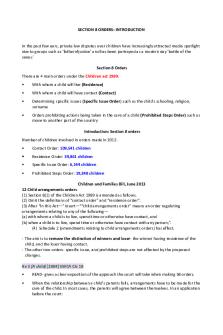Bullock and Sanderson Orders PDF

| Title | Bullock and Sanderson Orders |
|---|---|
| Course | Civil Dispute Resolution |
| Institution | University of Newcastle (Australia) |
| Pages | 2 |
| File Size | 71 KB |
| File Type | |
| Total Downloads | 73 |
| Total Views | 150 |
Summary
Summary of Bullock and Sanderson Orders...
Description
THE DIFFERENCE BETWEEN BULLOCK AND SANDERSON COSTS ORDERS (Dr John Woodward) A Bullock order takes its name from the case of Bullock v London General Omnibus Co [1907] 1 KB 264. It refers to an order where the plaintiff pays the costs of the successful defendant directly to that defendant and then adds those costs to the costs to be recovered from the unsuccessful defendant. A Sanderson order, which takes its name from Sanderson v Blythe Theatre Co [1903] 2 KB 533, is a variation of the Bullock Order where an unsuccessful defendant is ordered to pay the costs both of the plaintiff and the successful defendant. The difference can be represented diagrammatically as follows: P
D1 D2 Bullock Order
P
D1 D2 Sanderson Order
Figure 1 In modern litigation where much of the cost is carried by insurers, there is very little practical difference between these two types of orders. The real difference becomes important where the liable defendant (D2) is insolvent and unable to meet the liability. In that case, where a Bullock Order has been made, the successful defendant (D1) is entitled to recover its costs from the plaintiff, whether or not the plaintiff is able to recover against the insolvent liable defendant (D2). If a Sanderson Order has been made and D2 becomes insolvent, then both the plaintiff and D1 will miss out and D1 will not be able to recover against the plaintiff. Which, if either, of these two orders should be made, like all matters relating to costs, is within the discretion of the court: See section 98(1) of the CPA. The exercise of the discretion is governed by the principles set out in Nationwide News v Naidu; ISS Security v Naidu (No.2) [2008] NSWCA 71 (Nationwide) and the authorities referred to in that judgment which is extracted at page 149 of the textbook. Clearly, it is in the interests of the plaintiff to obtain a Sanderson order where possible because, in that case, the plaintiff is not at risk of having to pay the successful defendant’s costs without being able to recover them from the unsuccessful and insolvent defendant. As the Court of Appeal explained in Nationwide the plaintiff will be entitled to a Sanderson order where: (a) It was reasonable for the plaintiff to proceed against the successful defendant; and (b) The conduct of the unsuccessful defendant made it fair to impose liability on it for the costs of the successful defendant.
John Woodward 4th June 2020...
Similar Free PDFs

Bullock and Sanderson Orders
- 2 Pages

Varying and setting aside orders
- 4 Pages

Chapter 2 just following orders
- 5 Pages

Costs and costs orders(week 12)
- 5 Pages

S8 orders family law
- 15 Pages

SAP - Overhead Cost Orders
- 199 Pages

S8 orders - contact & residence
- 20 Pages

Anton Piller Orders - ghngfntg
- 2 Pages

Notes - Financial Orders
- 14 Pages

Education Supervision Orders
- 1 Pages

Orders of Business Correspondence
- 23 Pages

Precedents for Consent Orders
- 94 Pages
Popular Institutions
- Tinajero National High School - Annex
- Politeknik Caltex Riau
- Yokohama City University
- SGT University
- University of Al-Qadisiyah
- Divine Word College of Vigan
- Techniek College Rotterdam
- Universidade de Santiago
- Universiti Teknologi MARA Cawangan Johor Kampus Pasir Gudang
- Poltekkes Kemenkes Yogyakarta
- Baguio City National High School
- Colegio san marcos
- preparatoria uno
- Centro de Bachillerato Tecnológico Industrial y de Servicios No. 107
- Dalian Maritime University
- Quang Trung Secondary School
- Colegio Tecnológico en Informática
- Corporación Regional de Educación Superior
- Grupo CEDVA
- Dar Al Uloom University
- Centro de Estudios Preuniversitarios de la Universidad Nacional de Ingeniería
- 上智大学
- Aakash International School, Nuna Majara
- San Felipe Neri Catholic School
- Kang Chiao International School - New Taipei City
- Misamis Occidental National High School
- Institución Educativa Escuela Normal Juan Ladrilleros
- Kolehiyo ng Pantukan
- Batanes State College
- Instituto Continental
- Sekolah Menengah Kejuruan Kesehatan Kaltara (Tarakan)
- Colegio de La Inmaculada Concepcion - Cebu



